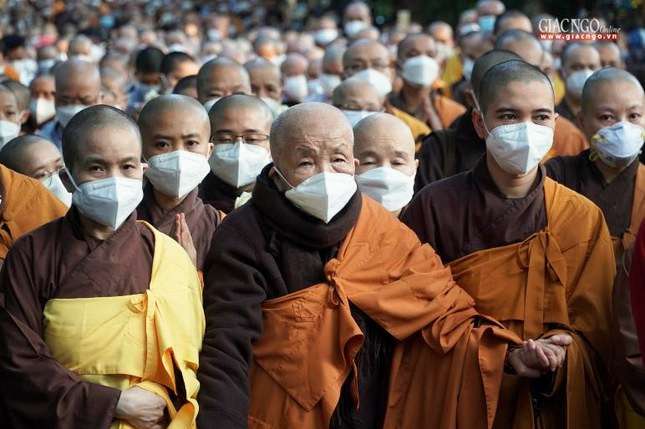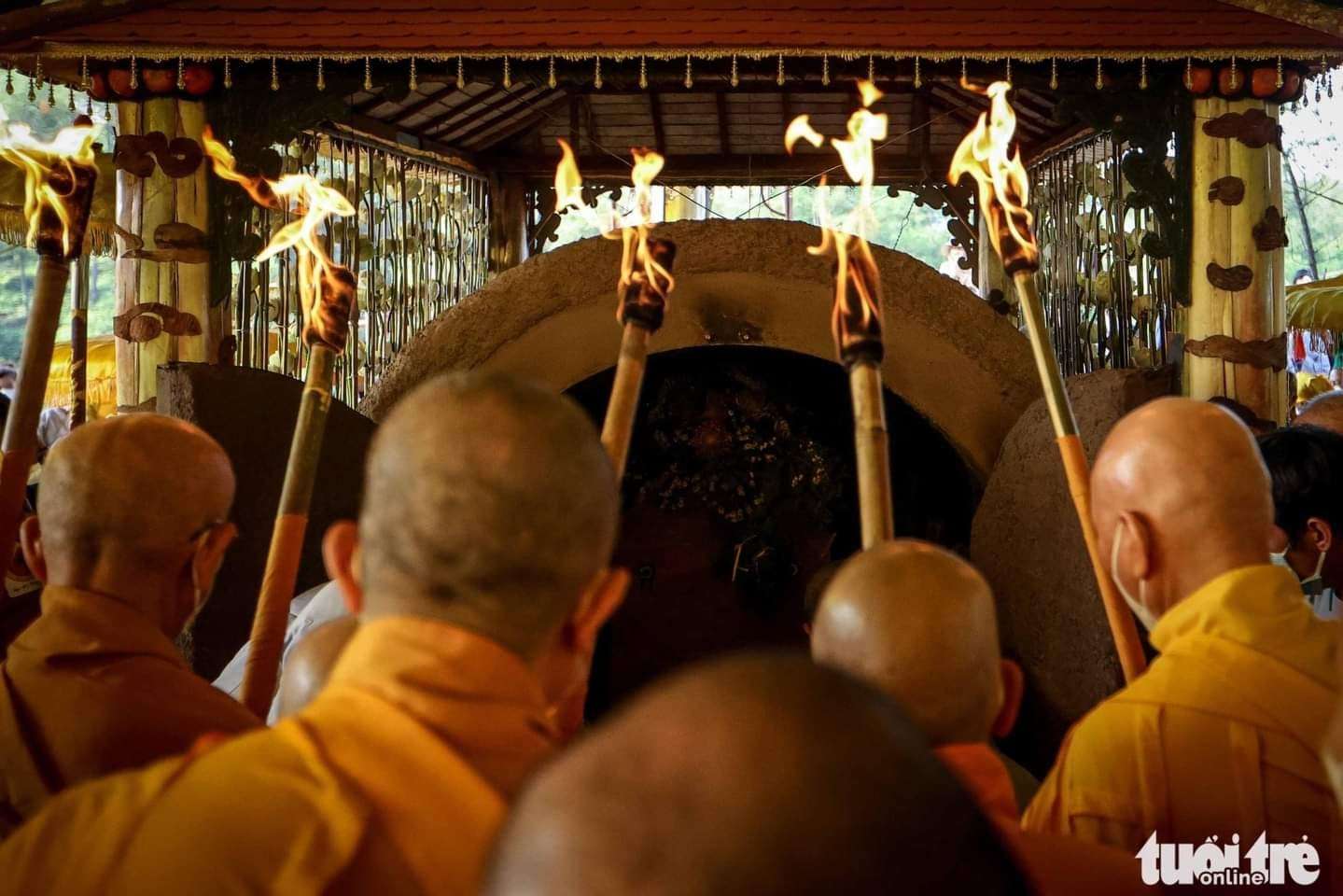Thay’s Memorial Ceremonies
At around midnight on 22nd January, 2022, in the Deep Listening Hut at Tu Hieu Root Temple in Hue, Vietnam, our beloved Teacher began to transform into a cloud. Surrounded by his attendants, and with the presence of Sister Chan Khong, Brother Phap Niem, Brother Phap Ung, Sister Dinh Nghiem, Sister Linh Nghiem, and Sister Thao Nghiem. Thay began his sacred and peaceful transformation. As his breathing slowed, the brothers and sisters joined their palms and gently sang Thay’s meditation, “Let the Buddha Breathe.”
As we shared the news to our monasteries around the world, the great temple bells began to sound, and Thay’s monastic students gathered in ceremonial robes in the meditation halls of Upper Hamlet, Lower Hamlet and New Hamlet in Plum Village, France; at the Maison de l’Inspir and Healing Spring monastery in Paris; the European Institute of Applied Buddhism in Germany; Deer Park Monastery in California; Blue Cliff Monastery in Upstate New York; Magnolia Grove Monastery in Mississippi; Lotus Pond Temple in Hong Kong; Plum Village Thailand; and in Australia at Mountain Spring Monastery near Sydney and Nhap Luu Monastery near Melbourne. The sangha sat in meditation, following our breathing, and sending Thay and our brothers and sisters in Hue all our love, peace, and compassion.
Thay gave his sangha seven incredible years of his presence and leadership since his stroke in November 2014. These were years of gentle, decisive, loving action; Thay did not simply “bide his time.” Thay’s courage and dignity despite adversity were deep lessons in compassionate action. When Thay miraculously survived the initial stroke in France, it was an act of love to stay with us a little longer. When he traveled to San Francisco for specialist treatments, he was teaching us never to give up on life’s wonders. When he spent a peaceful year in Plum Village in 2016, he was transmitting his love and trust to help us grow up. When he then chose to travel to Plum Village Thailand, it was to give a new generation of monks and nuns all his love and care, strengthening the foundation and activities of the new monastery. And when he finally chose to return to Tu Hieu Temple in Hue, where he first ordained, it was to “close the circle” with our ancestors, and offer the gift of peace, compassion, brotherhood and sisterhood to his beloved homeland, and to connect his international sangha to Vietnam. For many of us, Thay has been like a loving mother, and even the manner of his passing, so gently and lightly, after the remarkable gift of these sweet seven “bonus” years, felt full of love, trust, and peace.

When we formally announced the news on behalf of our community, word spread rapidly, with reports on all major news outlets, including the BBC, CNN, Sky News, Al Jazeera, and national newspapers around the world. It was extraordinary to witness a huge outpouring of appreciation and gratitude from countless thousands of people, who left messages on social media and on the Plum Village website. Many of them shared how Thay’s teachings had “saved their life” or helped heal their relationships, or had given them meaning, purpose, and hope when all was lost. Thay is a beloved teacher to more people than we could ever have imagined.
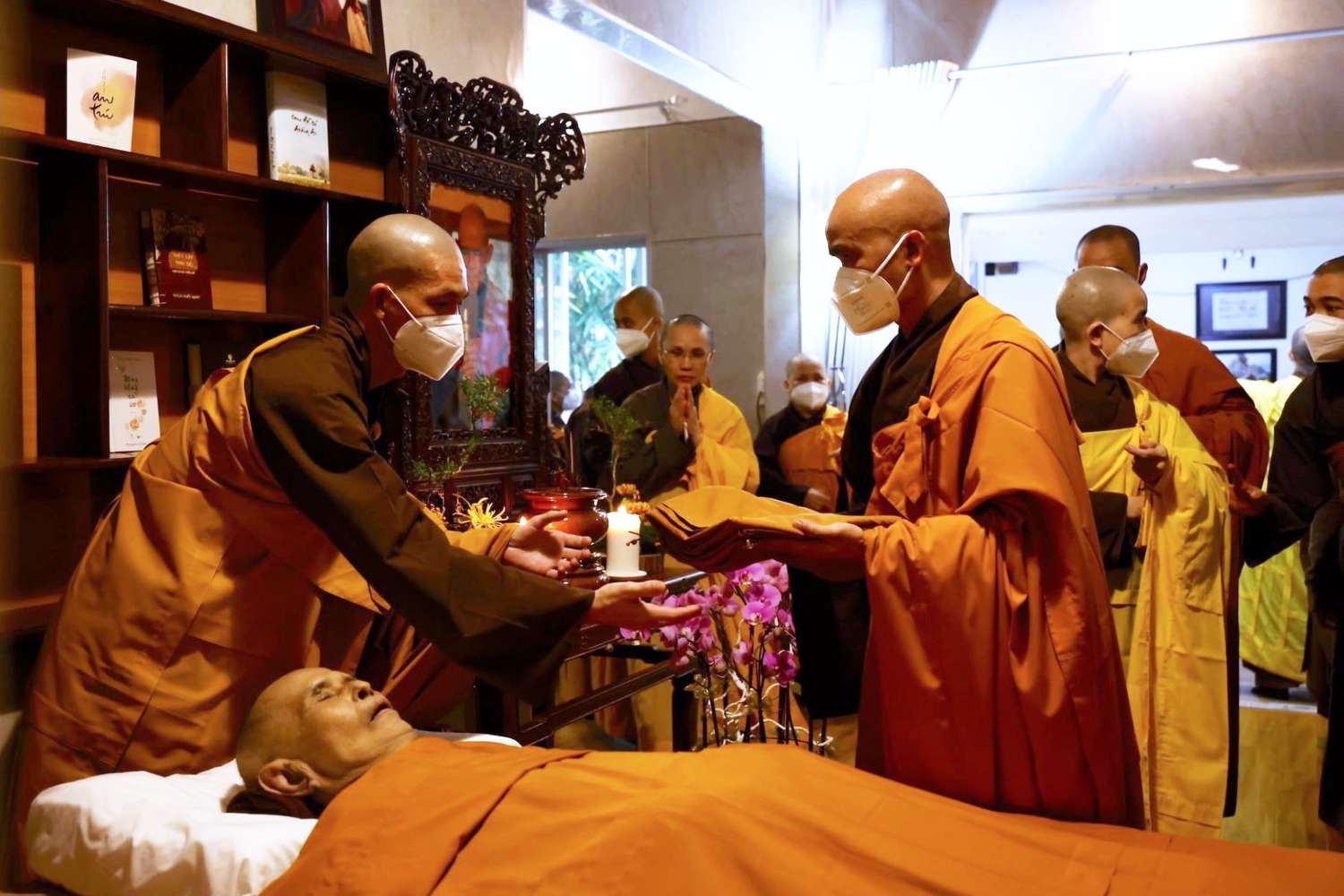
As preparations were underway in Vietnam, Deer Park Monastery in California was the first to hold a large ceremony in the Ocean of Peace Meditation Hall, livestreamed online and watched by tens of thousands of people. Plum Village, France soon followed, livestreaming sitting meditation and chanting from the Still Water Meditation Hall in Upper Hamlet. In Vietnam, hundreds of venerables, monastics, and lay practitioners gathered from around the country for the Casket Ceremony in the early morning of Sunday 23rd January. Tens of thousands of people watched the ceremony live on the Plum Village international and Vietnamese YouTube channels as Thay’s body was formally invited to be carried from the Deep Listening Hut to the Full Moon Meditation Hall. Monastics offered commentary in English to allow our friends around the world to understand the beautiful and deep ceremonial traditions of Vietnamese Buddhism.
As the sound of chanting the name of Avalokiteshvara rose up from the vast assembly gathered under canopies, we witnessed Thay’s body carried with grace and love through the temple grounds, above the heads of his beloved attendants and disciples who have cared for him day and night over the past seven years. As the sangha chanted, Thay’s body was raised ceremoniously three final times in front of the altar, before being gently placed in the casket, made of padauk wood from Hue, and covered with sandalwood and fragrant oils. Thay’s young monastic disciples from Dieu Tram Nunnery adorned the casket with simple garlands of precious ochre and gold chrysanthemums–Thay’s favorite flower.
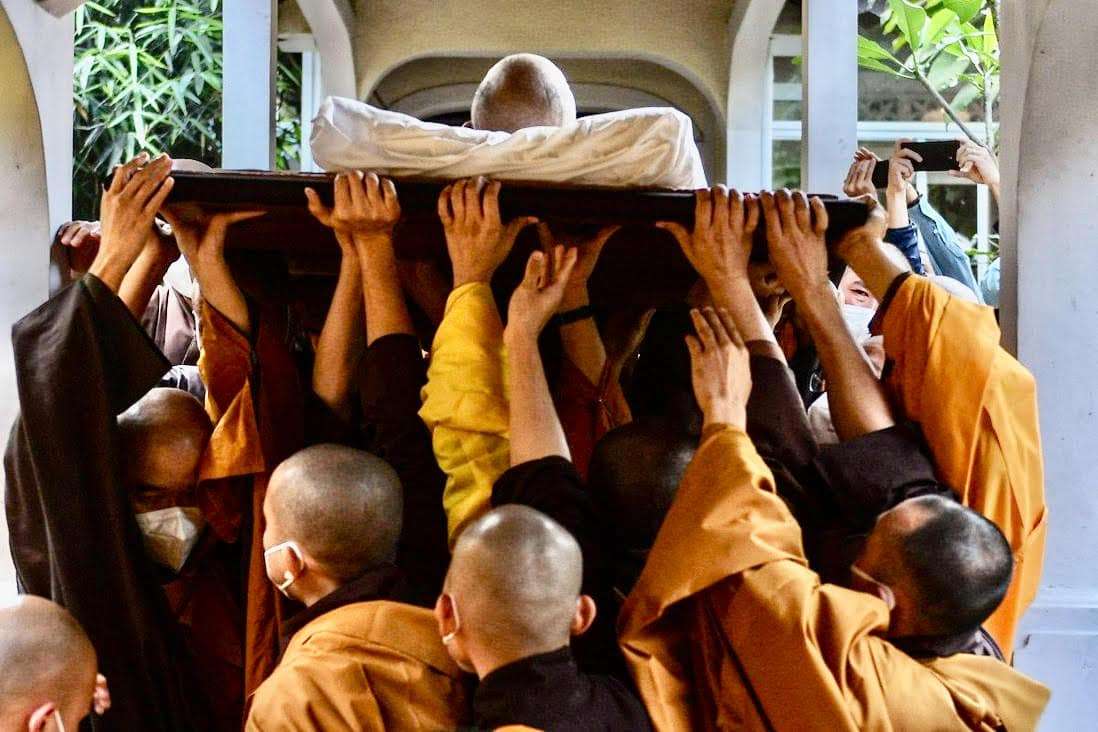
And with this, the sangha began a remarkable weeklong “memorial of the heart” (Tam Tang), to generate the energy of mindfulness, peace, and compassion in memory of our teacher and in honour of his legacy that lives on in his teachings, practices, and community. Thay’s monastic students kept vigil around his casket day and night. Over the coming days, thousands made the journey to Tu Hieu Temple to learn about mindful breathing and walking, to sit in meditation under the canopy, to circumambulate in mindfulness, and to pay their respects with mindful prostrations at Thay’s altar, and to express their gratitude in the Book of Condolences. Following Thay’s wish to offer the world a renewed Buddhism that can be accessible to all, the ceremonies were simplified to their essence, and offered in modern Vietnamese rather than Sino-Vietnamese, and included many of Thay’s own chants and translated texts. In this way, the chants could touch deeply the hearts of everyone who listened. People from all walks of life came to experience the peaceful, sacred atmosphere, among them representatives of the President and Prime Minister of Vietnam. We are deeply grateful that the government allowed such a huge gathering, even in the midst of a pandemic.
Monasteries in the Plum Village tradition around the world also participated in the weeklong “memorial of the heart,” and thousands gathered with local lay sanghas in Europe, America, Asia, and Australia to organize their own ceremonies of gratitude and remembrance. At Thay’s altars in every monastery on every continent, candles were kept alight through the nights, and each day the sangha poured Thay a cup of tea, and offered his favorite dishes, lovingly prepared.
In Plum Village, France, every day ceremonies were livestreamed to tens of thousands of practitioners from all over the world, who participated in the guided meditations, listened to the sutras, and savored the new Buddhist chants in our tradition, accompanied by cello, violin, and guitar. Plum Village’s weeklong program included an online Day of Mindfulness, with teachings, walking meditation and mindful eating, and also a special novice ordination day for young men and women entering monastic life. Novice Ordinations for this special “Mimosa” family were also held in Plum Village Thailand, Dieu Tram in Hue, and Blue Cliff and Deer Park Monasteries in the U.S.
This brings the number of monastic students ordained by Thay in the last thirty-four years to 1,214, as well as around one hundred more from other traditions who have taken refuge in Thay as their teacher. Since the 1990s Thay has transmitted the Dharma lamp to 759 monastic and lay disciples who continue to bring the light of his teachings into the world. During the course of the memorial week, in Europe, America, and Asia, Thay’s lay Dharma teachers hosted online meditations and Dharma sharings to embrace feelings of grief and tears, and to allow the community’s collective insights to ripen. During the first weeks since Thay’s passing, clips of Thay’s teachings and memorial ceremonies on the Plum Village YouTube channels received over 8 million views. It was as though Thay’s teachings and guidance were holding the global community in the embrace of right view. Our gratitude for his decades of deep teachings on no-birth, no-death and continuation overflowed.



As news spread of Thay’s passing, thousands began to share their personal stories of transformation and healing on the Plum Village website, and world leaders paid tribute to his contributions to peace, community, and collective awakening. As a community we were deeply moved by the affectionate words from His Holiness the Dalai Lama and renowned monks Matthieu Ricard and Father David Steindl-Rast, as well as from the Director General of the United Nations, the former President of the World Bank, the President of South Korea and many other distinguished voices. Obituaries in The New York Times, The Economist, and The Washington Post reflected a deep understanding of Thay’s life and legacy. Contemporary philosopher Rebecca Solnit, writing in The Guardian, eloquently expressed how Thay’s way of teaching Buddhism has transformed society, and changed the West for the better.
On Friday January 28th, in Hue, Vietnam; Plum Village, France; and Deer Park Monastery, California, special memorial sessions built towards the climax of Saturday’s funeral ceremony and cremation in Vietnam. At Tu Hieu Temple, high venerables gathered for the traditional ceremony (“Giac Linh”) to invite Thay’s energy to be present ahead of his cremation, and this was followed by a formal ceremony of respect and gratitude attended by distinguished guests, including official representatives of the people of the United States. Meanwhile, in Plum Village, France, Thay was remembered in moving musical and spoken tributes, including two newly composed songs of Thay’s poetry, a beautiful eulogy, and sharings from the heart. At Deer Park in California, the mahasangha gathered for the weekend to listen to a teaching from Br. Phap Dung, practise walking meditation along Thay’s path, and prepare to follow the funeral ceremony live from Vietnam.
On Saturday January 29th, tens of thousands gathered in the grounds of Tu Hieu Temple and along the streets of Hue to witness the solemn and moving final funeral ceremony and procession to the cremation park. It was the largest funeral in Hue in living memory. In Plum Village, France, the sangha gathered at 1:00 a.m. in the Still Water Meditation Hall to follow the funeral procession live, and offer commentary in English for tens of thousands of practitioners who were following live online.
The ceremony opened in the Full Moon Meditation Hall with the reading of Thay’s life at Thay’s altar by Br. Phap An, representing all Thay’s disciples and students, with all those present in Hue kneeling up behind him. Following the beauty and pageantry of Vietnamese tradition, there were more than three dozen pallbearers, decked in imperial gold and red, to bear Thay’s casket out of the meditation hall and through the temple grounds. The procession took place in a reverent silence, accompanied by the gentle tolling of the bell and rolling of the prajna drum, and witnessed by row upon row of devoted students holding fresh white lotus buds. Under golden parasols, Br. Phap An carried the incense, representing the connection to our ancestors; Br. Phap Niem and Br. Phap Ung carried Thay’s Memorial Dragon Plaque; Br. Phap Hoi and Br. Phap Khoi carried his portrait; Br. Phap Hai his sanghati robe; and Br. Phap Luu his simple alms bowl. Together these sacred objects led the procession of hundreds of monastics, as Thay’s casket wound its way through the temple grounds, along Thay’s cherished paths, around the half-moon pond and through the central portal of the Temple Gate representing the Three Doors of Liberation.
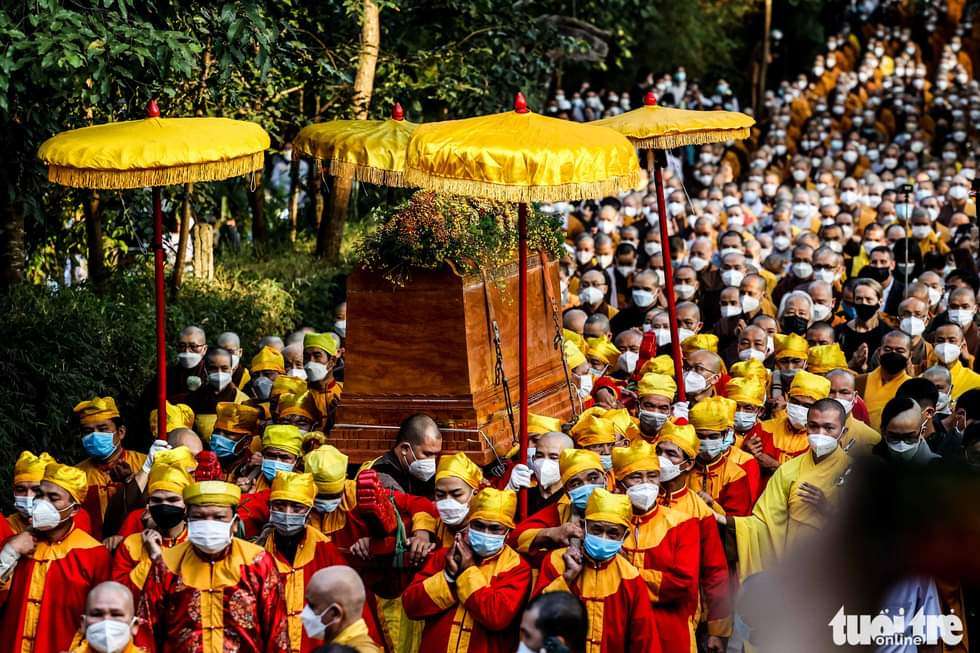
As the casket left the temple grounds, and dawn broke through the pines, thousands of people had a chance to witness the timeless beauty of this ancient ritual. After adding extra wooden shafts, the coffin was raised higher, higher, and higher again, in a wordless and unmistakable sign of respect and love, to be borne high above the heads of the pallbearers for the final journey past Thay’s beloved Duong Xuan Hill to the waiting cortege. Specially-decorated vehicles, adorned with flowers and golden cloth, were waiting to receive the casket and ceremonial objects. As the cortege of over 300 vehicles swept through the city and countryside, along the Perfume River, the roads were lined with devotees who touched the Earth in gratitude as Thay’s casket made its way to the “Paradise Garden” in the “Eternity Park.”
There, the procession approached the specially-built crematory, adorned with thousands of white lotuses and sheltered by a vast golden awning. As the congregation assembled, the distinguished venerables, and Br. Phap An representing the Plum Village International Community of Thay’s students, lit their torches at the Buddha’s altar and solemnly carried the sacred flames to the crematory. There, to the sound of chanting, the fire was lit and the crematory sealed with clay. For the next seventeen hours, the fire burned as the sangha kept vigil and practised sitting meditation, chanting, slow walking, and generating a sacred atmosphere of peace, compassion, and togetherness. The global audience was moved to tears by Sr. Chan Khong’s song, “I smile.” Thay would invite her to sing this song after every public talk as he quietly left the stage, and with bright eyes and great radiance, Sr. Chan Khong offered this song to help us accompany Thay in his transformation. Sr. Dinh Nghiem, with quiet dignity, strength and concentration, offered one of Thay’s favourite songs in French, “Le Bonheur,” and the sangha read letters and poems written for us by Thay. In a global first, these legendary moments were followed online by more than 100,000 people throughout the day, and many wrote to us to say that they did not miss a single moment of the hours-long live-streamed events.
At five in the morning on Sunday 30th January, the crematory was unsealed and Thay’s ashes brought out to cool and be gathered into urns, before being ceremoniously brought in procession, along with Thay’s sacred objects, back to Tu Hieu Temple. There, as the ashes were brought to the ancestral altar and Thay’s Deep Listening hut, the procession was formally greeted by monastics in sanghati and lay followers kneeling and bowing in respect. Shortly after the ashes arrived, a gentle auspicious rain began to fall on the city of Hue, following a week of golden sun.
Monday 31st January marked the eve of the Lunar New Year (“Tet”) of the Tiger. Thay’s monasteries around the world welcomed the new year and a new chapter, in Thay’s spirit, just as Thay’s own teacher encouraged him to enjoy the warmth of spring when he first gave him the name Phung Xuan–“Meeting the Spring.” Thay’s timing was perfect. The sangha was able to celebrate his memorial before the turning of the new year; and then celebrate his continuation during Tet, with poetry, music and oracles, and time together, taking care of each other as a spiritual family. As Thay taught us, “Now we have seen the path, there is nothing to fear.”
